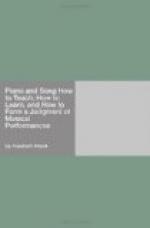When the foot-piece to the left on the piano is pressed down, the key-board is thereby moved to the right; so that, in playing, the hammers strike only two of the three strings, in some pianos only one. In that way the tone is made weaker, thinner, but more singing and more tender. What follows from this? Many performers, seized with a piano madness, play a grand bravoura piece, excite themselves fearfully, clatter up and down through seven octaves of runs, with the pedal constantly raised,—bang away, put the best piano out of tune in the first twenty bars,—snap the strings, knock the hammers off their bearings, perspire, stroke the hair out of their eyes, ogle the audience, and make love to themselves. Suddenly they are seized with a sentiment! They come to a piano or pianissimo, and, no longer content with one pedal, they take the soft pedal while the loud pedal is still resounding. Oh, what languishing! what soft murmuring, and what a sweet tinkling of bells! what tenderness of feeling! what a soft-pedal sentiment! The ladies fall into tears, enraptured by the pale, long-haired young artist.
I describe here the period of piano mania, which has just passed its crisis; a period which it is necessary to have lived through, in order to believe in the possibility of such follies. When, in the beginning of this century, the piano attained such conspicuous excellence and increased power, greater technical skill could not fail to be called out; but, after a few years, this degenerated into a heartless and worthless dexterity of the fingers, which was carried to the point of absurdity and resulted in intellectual death. Instead of aiming to acquire, before all things, a beautiful, full tone on these rich-sounding instruments, which admit of so much and such delicate shading, essential to true excellence of performance, the object was only to increase mechanical facility, and to cultivate almost exclusively an immoderately powerful and unnatural touch, and to improve the fingering in order to make possible the execution of passages, roulades, finger-gymnastics, and stretches, which no one before had imagined or considered necessary. From this period dates the introduction of virtuoso performances with their glittering tawdriness, without substance and without music, and of the frightful eccentricities in art, accompanied by immeasurable vanity and self-conceit,—the age of “finger-heroes.” It is indeed a melancholy reflection, for all who retain their senses, that this charlatanry is made the solitary aim of numberless ignoble performers, sustained by the applause of teachers and composers equally base. It is sad to see how, engaged in artificial formalisms and in erroneous mechanical studies, players have forgotten the study of tone and of correct delivery, and that few teachers seek to improve either themselves or their pupils therein. Otherwise they would see and understand that, on a good piano, such as are now to be found almost everywhere, it is




